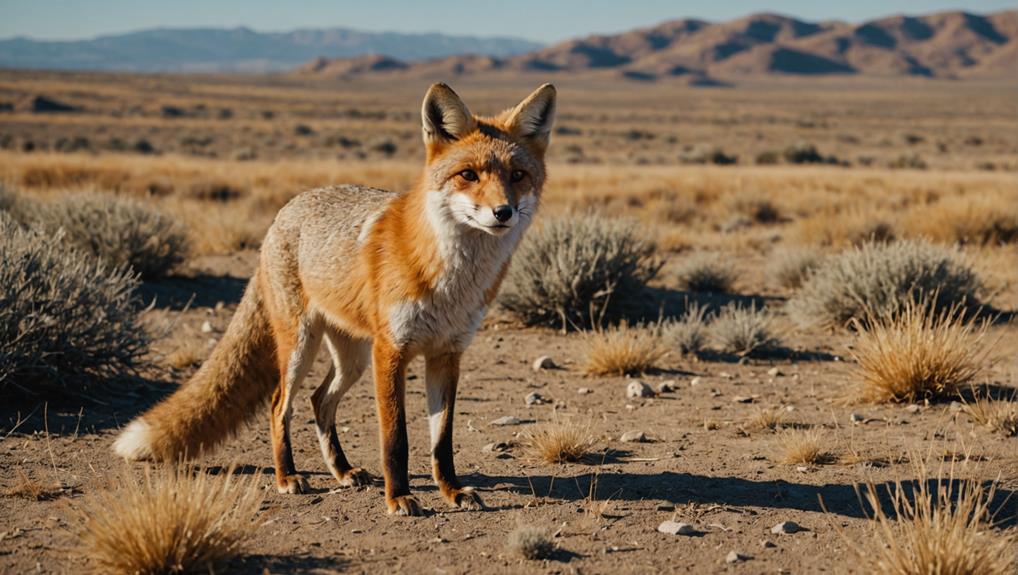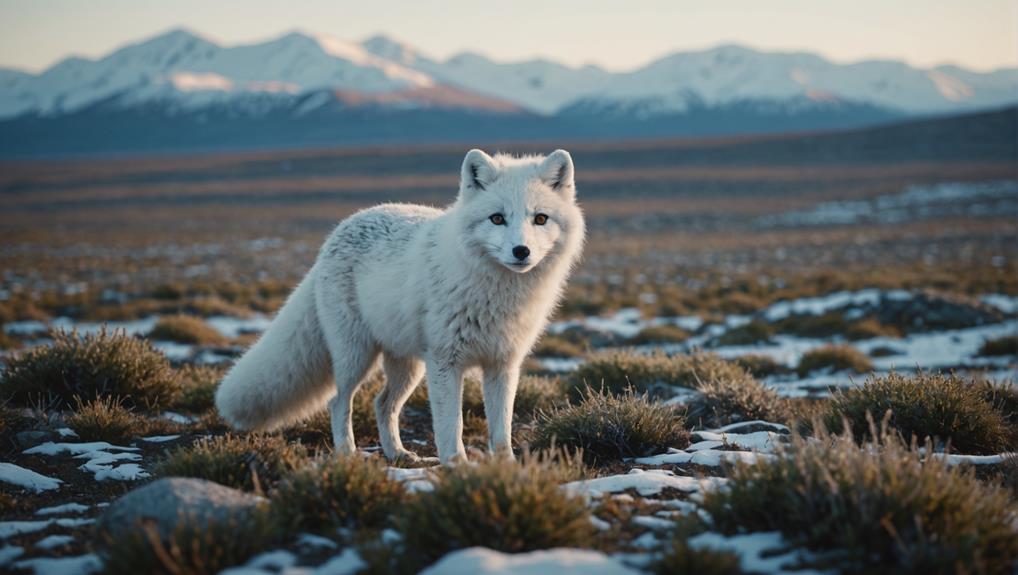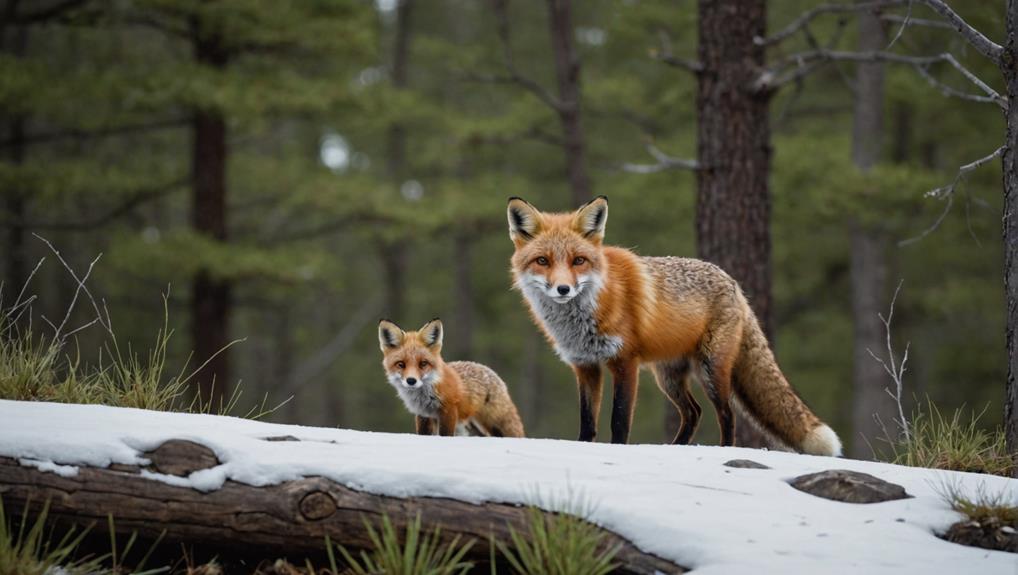North America is home to some pretty cool fox species, each with unique habits and homes. The Red Fox hangs out in woodlands and urban areas, sporting that striking orange coat. The Gray Fox prefers forested spots and can even climb trees—fancy, right? In the chilly tundra, you'll find the Arctic Fox, which changes fur color like it's trying out fashion trends. The Kit Fox thrives in deserts, while the Swift Fox zooms around avoiding predators. There are even rarer ones like the Island Fox. Curious to know about their conservation efforts and challenges? Stick around to find out!
Contents
- 1 Overview of Fox Species
- 2 Red Fox Habitats and Characteristics
- 3 Swift Fox Adaptations and Range
- 4 Kit Fox Behavior and Environment
- 5 Arctic Fox Survival in Tundra
- 6 Gray Fox Forest Habitats
- 7 Island Fox Conservation Status
- 8 Corsac Fox Distribution and Habitat
- 9 Other Notable Fox Species
- 10 Habitat Diversity and Conservation Efforts
- 11 Final Thoughts
Overview of Fox Species
Fox species in North America showcase remarkable diversity, each uniquely adapted to its environment. You might be surprised to learn that there are four primary species here: the Red Fox, Gray Fox, Arctic Fox, and Kit Fox. Each one has its own quirks and habitats to thrive in.
Notably, the Red Fox is the largest true fox species, known for its adaptability to various habitats, including diverse environments from bustling urban areas to quiet farmlands.
The Gray Fox, a bit of a climbing expert! These woodland dwellers can scale trees, which helps them escape chilly climates. Their gray coat, accented with rusty hues, blends beautifully into their forest homes.
And let's not forget the Arctic Fox, a true master of cold survival. With its seasonal fur color change—from brown in summer to white in winter—this little guy is perfectly suited for the tundra.
Weighing around 15 pounds, they're the warm-hearted champions of harsh conditions.
Red Fox Habitats and Characteristics
When you think of red foxes, picture a charming critter with a fiery orange coat and a bushy tail that seems to have a life of its own.
These clever animals thrive in all sorts of places, from dense forests to bustling cities, showcasing their adaptability in varied environments.
Their preferred habitats include mosaic forests and open grasslands, demonstrating their ability to navigate diverse ecosystems while hunting for food.
As we explore their habitats, physical traits, and quirky eating habits, you'll see just how fascinating these little hunters really are!
Preferred Habitat Types
Red foxes thrive in diverse habitats, showcasing their remarkable adaptability across North America. You might find these clever creatures in forests, grasslands, deserts, and even urban areas!
Their preference leans toward mixed vegetation, especially in edge habitats that blend agricultural fields with woodlands. This combination offers them plenty of food and shelter, making it a cozy spot for a red fox. They're particularly effective in utilizing mixed landscapes with transition zones, which aid in their hunting strategies.
Interestingly, red foxes are widespread in North America, but they tend to steer clear of the southern Great Plains and southern Texas. You'll spot them happily roaming through Canada and the northeastern U.S.
Their bushy tails aren't just for show; they help with communication and keep them warm in chilly climates.
However, they do face competition from larger predators like coyotes and wolves, which can affect where they choose to live.
Physical Adaptations Overview
Often found in a variety of environments, red foxes exhibit physical adaptations that enhance their survival and hunting abilities. These charming creatures, known scientifically as Vulpes fulva, thrive in habitats like forests, grasslands, farmlands, and even bustling urban areas.
Standing about 15 inches tall and weighing between 8 to 14 pounds, they sport a striking orange-red coat with black legs and a fluffy white-tipped tail. Their bushy tails aren't just for show; they help keep red foxes warm and balanced while also serving as a communication tool among themselves.
Have you ever seen a fox darting through snow? Their sharp hearing lets them detect prey hiding beneath the surface, while their vertical pupils give them an edge in low-light conditions—perfect for those late-night hunting trips.
As solitary hunters, they stalk small mammals, birds, and even fruits, showcasing their adaptable nature. Thanks to these physical adaptations, red foxes can thrive in diverse habitats and make a living wherever they go.
Who knew that such a clever little creature could be so versatile? It's just another reason to appreciate the wonders of nature!
Behavioral Traits and Diet
The behavior and diet of foxes reveal their adaptability and resourcefulness. You'll find the Red Fox (Vulpes vulpes) is quite the clever critter! These little omnivores primarily feast on small mammals like voles and rabbits, but they've got a sweet tooth, too, often snacking on fruits and berries when they're in season.
Their diet really reflects their ability to thrive in diverse habitats, from lush forests to bustling urban areas.
When hunting, Red Foxes show off their stealthy side, stalking quietly before pouncing. They usually prefer to go solo, which makes sense since they can sneak up on their prey without any distractions.
Communication is key for these foxes, and they use a range of vocalizations, from barking to yapping, to establish territory and connect with others.
For shelter, they're pretty resourceful, using abandoned burrows or digging dens in safe spots. These dens protect them from predators and harsh weather while raising their adorable kits—usually three to six of them!
Swift Fox Adaptations and Range

In the expansive landscapes of the Great Plains, swift foxes (*Vulpes velox*) have evolved remarkable adaptations that enable them to thrive in short grasslands and prairies.
These little guys, weighing between 5 to 8 pounds and standing just 12 to 16 inches tall at the shoulder, are built for agility and speed. Imagine them zipping across the open spaces, hunting at night for small mammals, insects, and even a bit of vegetation. This nocturnal lifestyle not only makes them efficient hunters but also helps them dodge larger predators during the day.
Their social structure adds another layer of charm. Female swift foxes usually defend their territories solo, while males roam around, creating a fascinating dance of resource sharing. You might say they've a unique family dynamic!
Swift foxes call a range that stretches from southern Canada down into parts of central and western United States their home. They've got a knack for finding cozy denning sites, often snatching them from other burrowing animals.
These adaptations make them truly remarkable residents of their Great Plains habitat, don't you think?
Kit Fox Behavior and Environment
When you think about kit foxes, picture tiny furballs that thrive in the desert!
These little guys are mostly solo adventurers, but they've got some unique quirks in their social behavior, like chattering away to each other in their cozy burrows.
Their habitat choices reflect their playful nature; they love to roam the arid landscapes where their keen ears help them track down dinner, even if it's hiding underground!
Habitat Preferences
Kit foxes thrive in the arid landscapes of North America, expertly navigating their desert habitats.
These charming little foxes, the smallest in the region, prefer areas with low vegetation and sandy soils. You'll typically find them in the southwestern United States, stretching from southern Oregon all the way down to northern Mexico, where they feel right at home below elevations of 4,500 feet.
Their habitat preferences make them masters of adaptation. With their large ears, kit foxes not only keep cool but also hear everything around them—like that sneaky rabbit trying to escape!
During the scorching daytime, these clever creatures stay hidden in their burrows, avoiding the heat. Once the sun sets, they come alive, hunting for small rodents, rabbits, and even insects, demonstrating their opportunistic feeding habits.
Social Behavior Patterns
A fascinating aspect of kit fox social behavior is their strong family bonds, which play a crucial role in their survival. You'll find that kit foxes thrive in family groups, where they work together to rear their young.
Both parents take an active role in nurturing and protecting their kits, teaching them essential skills for life in the wild. Isn't that sweet?
These clever little creatures are also quite social, communicating through unique vocalizations, including a distinct chattering sound that sets them apart from other foxes.
Imagine the chatter filling the night air! Their adaptability shines as they navigate desert and brushy habitats, using quick escapes through secondary burrow entrances to dodge predators.
While kit foxes maintain overlapping home ranges with their neighbors, they still defend their territories fiercely.
This balance between cooperation and competition showcases their complex social behavior.
So, next time you think of these adorable foxes, remember that their strong family dynamics and communication skills are key to their success in the wild.
It's all about teamwork in the desert!
Arctic Fox Survival in Tundra

Survival in the harsh tundra is no small feat, but the Arctic fox (Alopex lagopus) has mastered it through remarkable adaptations. You'll find these clever creatures thriving in their cold habitat, thanks to their thick fur that provides excellent insulation.
Imagine being wrapped in a cozy blanket all winter long—that's how the Arctic fox feels!
One fascinating trick of the Arctic fox is its seasonal fur color change. In summer, they sport a brown coat, blending seamlessly with the tundra. Come winter, they turn white, camouflaging against the snow. It's like having a built-in disguise!
When it comes to food, these resourceful foxes primarily feast on small mammals such as lemmings and rodents. But when winter bites hard, they become scavengers, sniffing out remains from larger animal kills.
Their incredible hearing helps them locate prey buried beneath the snow, and they can even create pathways in the frozen landscape.
With an average weight of about 15 pounds, the Arctic fox showcases extraordinary adaptations that allow it to thrive where few others can.
Isn't it inspiring how nature equips these little survivors?
Gray Fox Forest Habitats
When you think about gray foxes, picture them roaming through lush forests filled with trees and shrubs.
These clever little critters not only love to hang out in mixed woodlands but are also great climbers—who knew foxes could be part-time tree huggers?
With their knack for finding food and shelter in these habitats, gray foxes make the most of their forest homes, just like you might enjoy a cozy corner of your favorite park!
Preferred Forest Locations
Gray foxes thrive in forested environments, particularly in mixed woodlands where dense shrubs provide both cover and food. These clever little creatures prefer wooded locations that offer plenty of foliage, making it easier for them to hide from predators and find tasty meals. Think of them as the ultimate forest ninjas, sneaking around their leafy homes!
You'll find gray foxes mostly in the eastern, northcentral, and southwestern United States. They love areas with milder winters, where they can cozy up in denning spots like hollow logs or rocky crevices.
Unlike their red counterparts, gray foxes stick to wooded environments, which helps shape their social behavior and population density. It's fascinating how their choice of habitat influences their lives!
If you ever get the chance to explore these preferred forest locations, keep an eye out for these elusive foxes. You might just spot one darting through the underbrush or perched on a branch, showcasing their unique climbing skills.
Adaptations to Wooded Environments
Living in forested areas has equipped gray foxes with remarkable adaptations that enhance their survival in these environments. These clever creatures are like nature's little ninjas, thriving in habitats filled with dense vegetation. Their ability to climb trees sets them apart from other fox species, giving them quick escape routes from predators and a chance to snag some tasty treats.
Their beautiful salt-and-pepper gray fur, with hints of rusty yellow, helps them blend seamlessly into the dappled light of the forest floor. Plus, they've got a knack for finding cozy dens in hollow logs or rock crevices, keeping them safe from larger threats and the elements.
Here's a quick look at some of these amazing adaptations:
| Adaptation | Purpose | Benefit |
|---|---|---|
| Tree Climbing | Escape from predators | Access to food, safety |
| Camouflage | Blend into surroundings | Avoid detection by predators |
| Denning in Cavities | Protection from weather and danger | Safe resting place |
| Solitary Lifestyle | Territory establishment | Less competition for resources |
Together, these adaptations make gray foxes true masters of their wooded habitats.
Island Fox Conservation Status

The conservation status of the Island Fox (*Urocyon littoralis*) is a critical concern for wildlife enthusiasts and conservationists alike. This adorable little fox, native to California's Channel Islands, has faced some serious challenges.
By the late 1990s, its population plummeted to fewer than 100 individuals on certain islands, mostly due to habitat loss and predation from non-native golden eagles. Talk about a rough patch!
Fortunately, there's good news! Conservation efforts have ramped up, and they're making a real difference. With programs focused on captive breeding, habitat restoration, and controlling those pesky invasive predators, the Island Fox population has bounced back to over 1,000.
It's like a comeback story for the ages! Organizations like the National Park Service are actively monitoring these cute critters, ensuring their genetic diversity and long-term survival.
However, don't let the numbers fool you—this little fox is still classified as "Near Threatened" by the IUCN.
We need to continue supporting these conservation efforts to keep the Island Fox safe and thriving. After all, what's better than seeing these charming foxes frolicking in their natural habitat? Let's keep the momentum going!
Corsac Fox Distribution and Habitat
While the Island Fox makes its home on the Channel Islands, the Corsac Fox (*Vulpes corsac*) roams the expansive grasslands and steppes of Central Asia. You'll find this clever creature in places like Mongolia, northern China, Kazakhstan, and even southeastern Europe. These foxes thrive in open habitats, preferring short vegetation, shrublands, and semi-deserts. It's like they're designed for a life of stealthy hunting, looking for small mammals and birds.
What's interesting is that Corsac Foxes adapt well to different terrains, from plains to rocky hills. However, they shy away from heavily wooded areas since thick vegetation can make hunting tricky. Imagine trying to sneak up on dinner in a dense forest—it's not easy!
Sadly, their distribution faces challenges due to habitat changes from agriculture and human development. They've got to compete with other canids too, which can make life tougher.
Other Notable Fox Species

Among the diverse fox species in North America, several stand out for their unique adaptations and habitats. You'll find the Arctic Fox, Gray Fox, and Kit Fox each thriving in their own special ways.
| Fox Species | Habitat Type |
|---|---|
| Arctic Fox | Cold tundra |
| Gray Fox | Wooded areas |
| Kit Fox | Desert and brushy areas |
The Arctic Fox is a true survivor, with its stunning fur changing from brown in summer to white in winter. This camouflage helps it navigate the snowy tundra while hunting for food. Then there's the Gray Fox, which loves to climb trees! Yes, climbing! They prefer wooded habitats and can be spotted across the eastern and southwestern U.S.
And let's not forget the Kit Fox, the smallest of the bunch, weighing only 4 to 6 pounds. You'll find this little guy in desert and brushy areas, showcasing its agility and charm. Each of these foxes contributes to the beautiful tapestry of wildlife in North America. So, whether you're hiking in the woods or exploring the deserts, keep your eyes peeled for these remarkable creatures!
Habitat Diversity and Conservation Efforts
Diverse habitats across North America play a crucial role in the survival of various fox species.
These clever little wild animals adapt to their surroundings in remarkable ways. Here are three key habitats where they thrive:
- Woodlands: Gray foxes love climbing trees and find shelter among the branches.
- Grasslands: Red foxes adapt well to mixed landscapes, even cozying up in urban areas.
- Deserts: Kit foxes dig burrows in sandy soils, perfectly suited for their arid homes.
Habitat preservation is essential for foxes generally, as urbanization and climate change threaten their natural environments.
By protecting these diverse ecosystems, we can help ensure that these beautiful creatures continue to thrive.
You see, every little effort counts! Whether it's supporting local conservation groups or simply spreading awareness, there's plenty you can do.
Final Thoughts
In conclusion, foxes are fascinating creatures that thrive in a variety of habitats across North America. From the clever red fox to the elusive kit fox, each species has its own unique traits and challenges. Protecting their homes is crucial, so let's support conservation efforts to keep these charming animals around for generations to come. After all, who wouldn't want to spot a fluffy fox on a nature walk? They're the ultimate wildlife show-offs, and we're lucky to share our spaces with them!














